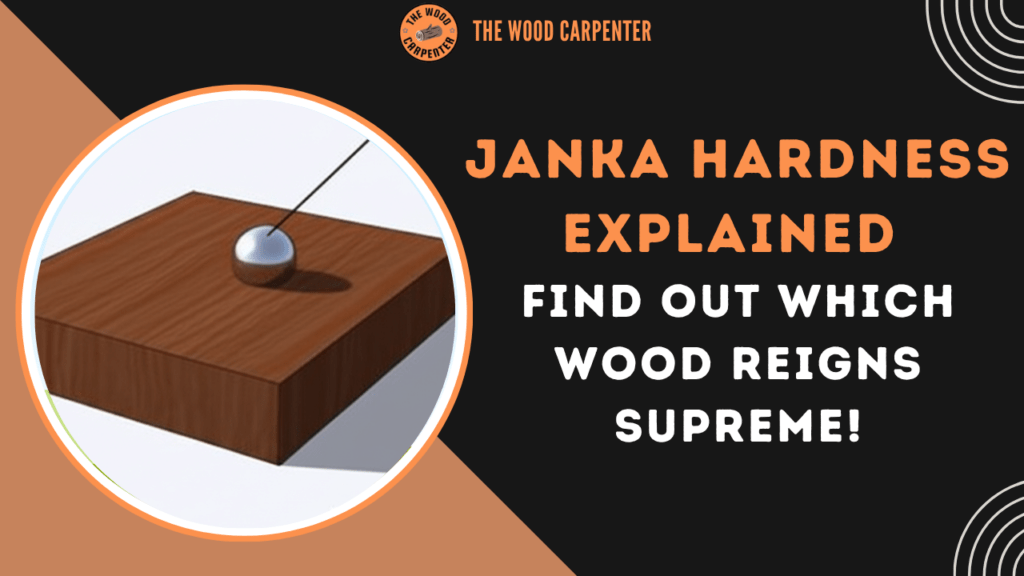
What Is the Janka Hardness Test ?
The Janka hardness test is a standardized method for measuring the resistance of wood to denting and wear. Developed by Gabriel Janka in the early 20th century, the test determines how much force is required to embed a steel ball with a diameter of 11.28 mm (0.444 inches) halfway into a sample of wood.
The resulting number, usually expressed in pounds-force (lbf), kilograms-force (kgf), or newtons (N), provides a clear, comparative measure of a wood species’ hardness.
Why Does Janka Hardness Matter ?
Durability: Harder woods are more resistant to dents, scratches, and general wear, making them ideal for high-traffic flooring, countertops, and furniture.
Workability: Softer woods are easier to cut, sand, and nail, but may not withstand heavy use as well as harder species.
Suitability: The Janka rating helps woodworkers, builders, and homeowners select the right wood for specific applications, balancing hardness with other factors like appearance and cost.
How Is the Test Performed ?
- A steel ball is pressed into the wood until it reaches half its diameter.
- The force required is recorded as the Janka hardness value.
- The test is typically performed on wood samples with 12% moisture content, and results can vary depending on whether the force is applied perpendicular (side hardness) or parallel (end hardness) to the wood grain.
Janka Hardness of Common Hardwoods
| Hardwood Species | Janka Hardness (lbf) |
| Balsa | 100 |
| Chestnut | 540 |
| Poplar | 540 |
| Sycamore | 770 |
| Mahogany (Honduran) | 800 |
| Cherry | 950 |
| Maple (Soft) | 950 |
| Walnut (Black) | 1,010 |
| Teak | 1,080 |
| Oak (Red) | 1,290 |
| Oak (White) | 1,360 |
| Ash (White) | 1,320 |
| Beech | 1,300 |
| Maple (Hard) | 1,450 |
| Hickory | 1,820 |
| Pecan | 1,820 |
| Merbau | 1,712 |
| Wenge | 1,630 |
| Padauk | 1,725 |
| Santos Mahogany | 2,200 |
| Rosewood (Brazilian) | 2,200 |
| Jatoba (Brazilian Cherry) | 2,350 |
| Purpleheart | 2,520 |
| Olivewood | 2,690 |
| Bloodwood | 2,900 |
| Brazilian Ebony | 3,220 |
| Ipe | 3,510 |
| Cumaru (Brazilian Teak) | 3,540 |
| Lignum Vitae | 4,390 |
Janka Hardness of Common Softwoods
| Softwood Species | Janka Hardness (lbf) |
| Eastern White Pine | 380 |
| Western Red Cedar | 350 |
| Basswood | 410 |
| Aspen | 430 |
| Willow | 430 |
| Fir (Balsam) | 460 |
| Hemlock | 540 |
| Douglas Fir (Coastal) | 660 |
| Southern Yellow Pine | 690 |
| Larch | 830 |
| Spruce (Sitka) | 510 |
| Spruce (White) | 480 |
| Spruce (Black) | 520 |
| Cypress | 510 |
The Extremes: Softest and Hardest Woods
Softest: Balsa wood sits at the bottom of the scale, with a Janka rating of around 100 lbf, making it extremely easy to dent and shape.
Hardest: Lignum vitae is among the hardest, with a Janka rating exceeding 4,300 lbf. Other extremely hard woods include Ipe and Brazilian Ebony, both favored for their durability in demanding applications.
Practical Applications
Flooring: Hardwoods like Oak, Maple, and Hickory are preferred for flooring due to their high Janka ratings, ensuring resistance to foot traffic and furniture movement.
Furniture: Woods with moderate hardness, such as Cherry and Walnut, balance workability with durability, making them popular for fine furniture.
Specialty Uses: Ultra-hard woods like Ipe and Lignum Vitae are used for outdoor decking, tool handles, and industrial applications where extreme durability is required.
Choosing the Right Wood
When selecting wood for a project, consider the Janka hardness in relation to the intended use:
High-traffic areas: Choose woods with a Janka rating above 1,200 lbf.
Decorative or low-wear items: Softer woods may suffice and are easier to work with.
Specialty applications: For outdoor or industrial use, opt for woods with the highest ratings.
Final Thoughts
The Janka hardness scale is an essential tool for anyone working with wood. By understanding these ratings, you can make informed choices that balance beauty, durability, and practicality in your woodworking projects.
Frequently Asked Questions (FAQs)
1. What is the Janka Hardness Test?
The Janka Hardness Test measures the force required to embed a steel ball halfway into a wood sample. It’s a standardized way to compare the hardness and dent-resistance of different wood species.
2. Why is Janka hardness important when choosing wood?
Janka hardness helps you select the right wood for your project. Harder woods are better for high-traffic floors and heavy-use furniture, while softer woods are easier to work with for carving or decorative projects.
3. Does a higher Janka rating mean better quality wood?
Not necessarily. A higher Janka rating means the wood is harder and more resistant to dents, but it may also be more difficult to work with and more expensive. The “best” wood depends on your specific needs.
4. Are hardwoods always harder than softwoods?
No. While hardwoods are generally harder, there are exceptions. Some softwoods can be harder than certain hardwoods, and some hardwoods (like balsa) are very soft.
5. How does Janka hardness affect flooring choices?
For flooring, woods with a Janka rating above 1,000 lbf are recommended for durability. Hardwoods like oak, maple, and hickory are popular choices for high-traffic areas.
6. Can I use softwood for furniture?
Yes, softwoods like pine and cedar are often used for furniture, especially where ease of working and a lighter weight are desired. However, they may dent or scratch more easily.
7. Does wood hardness affect how easy it is to cut or nail?
Yes. Harder woods can be more challenging to cut, sand, or nail, and may require pre-drilling or specialized tools. Softer woods are easier to work with hand tools.
8. Are exotic woods always harder than domestic ones?
Many exotic woods (like Ipe, Cumaru, and Jatoba) are extremely hard, but not all. Always check the Janka rating for the specific species.
9. Does wood hardness change over time?
The hardness of wood can change slightly as it dries and ages, but the Janka rating is a reliable guide for comparing species.
10. Where can I find the Janka hardness of a specific wood?
Resources like The Wood Database, flooring manufacturer websites, and woodworking handbooks provide comprehensive Janka hardness charts for hundreds of wood species.
11. Is Janka hardness the only factor to consider when choosing wood?
No. Consider other factors such as grain, color, stability, cost, workability, and availability for your project.
12. What are some of the hardest and softest woods?
Hardest: Lignum Vitae, Ipe, Cumaru, Brazilian Ebony
Softest: Balsa, Eastern White Pine, Western Red Cedar

